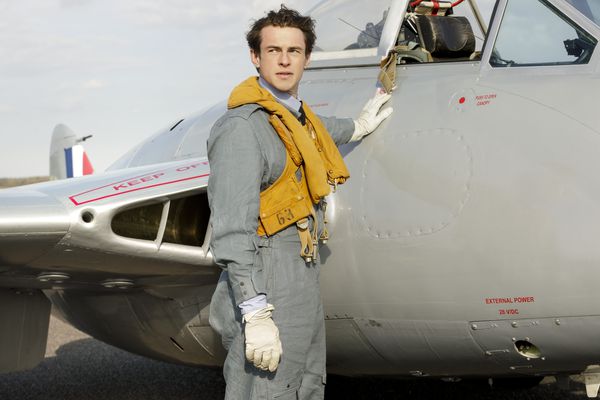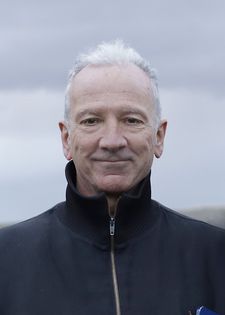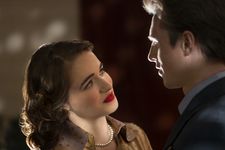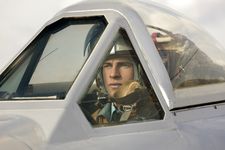 |
| Ben Radcliffe in The Shepherd Photo: courtesy of Disney |
Most short films are relatively low budget affairs and, accordingly, exercise caution about the challenges they take on, but that’s not the only way to make them. Amongst those shortlisted for this year’s Oscars is Iain Softley’s The Shepherd, which follows the journey of pilot Freddie (Ben Radcliffe), who finds himself in unexpected peril when he suffers a catastrophic instrument failure whilst flying alone in a small plane at night. All Freddie wants is to get back home to his girlfriend for Christmas, but as time passes, in a strange world defined by bright stars and an enormous moon, he is forced to reckon with his mortality.
Iain has made some highly successful features in the past, from The Wings Of The Dove to Inkheart, but here he explores the short form for the first time. It’s all the more exciting then, to get this kind of attention, and the more so, he explains to me, because the film was initially conceived as something quite different.
 |
| Iain Softley Photo: courtesy of Disney |
“We were going to do The Shepherd as a long film,” he explains. “My friend Alfonso Cuarón had discussed it with me a few years earlier when I was already committed to do it as a movie, and then he came back to me and asked ‘How's it going? Are you in production?’ And that was during the pandemic. Of course, we'd ground to a halt. So I grasped the opportunity to reconceive it and rewrite the screenplay as a shorter version.
“It was interesting because I think a lot of people have this idea of short films as being, I don't know, 10 or 20 minutes. But Alfonso is a big advocate of the shorter form. I mean, Gravity was actually a relatively short film. We're 38 minutes long, but it's an interesting length to try and compress quite an emotional journey into. I think people have responded to that. They like the fact that it's more condensed.”
It feels like a very personal film, I say, and he nods.
“I only really get involved with a film if I respond to the material in a very personal way. Whether it's a preexisting script or a book or some source material. I feel immediately that I can make the film because I see the film in my mind, and I feel very connected. And when this was pitched to me, I wasn't expecting to feel so connected to the story. I read the novella written by Freddie Forsythe and it was in the process of adapting it that I realised why. I like the idea of the existential question, if you like, that you're faced with when you're isolated in nature.
“I think being above the planet, being above the Earth gives us a rather magical perspective. One can imagine the pilot being confronted with thoughts that he wouldn't normally have when he's in a more familiar earthbound environment. I mean, I thought a lot of Saint-Exupéry, the author of The Little Prince, who was a very early pilot. He was a mail pilot just after the first World War, I think. And he wrote books about that sort of philosophical, almost meditative state of being above the clouds.
“One of my favorite poems is a WB Yeats poem, An Irish Airman Foresees His Death. I think the focus line is, ‘I know that I shall meet my fate somewhere among the clouds above.’ I was struck by that. I was very excited about the idea of creating the world and that immersive environment that the story would take place in.
“Beyond that, when I started to look into how to connect us to the character of Freddie, I was looking for ways of really elucidating on who he was and what his journey was – what sort of person he was at the beginning, and the person that he becomes at the end of the journey, after those life changing experiences. I needed to do that because the novella is a monologue, so it's very appropriate for radio. If you just read the book. It doesn't need that at all. It doesn't need dramatising. It's just a straight read. But I didn't want a voiceover all the way through. I wanted to dramatise it.
‘So I got into his background, and I was thinking my father. And to me, it became a story about the gap there sometimes is between the son and the father, and the misunderstanding of expectations. And in the case of Freddie, where his father is somebody who died in the war, it's almost like he can aspire, but he can never – in his view – attain that status that his father has. And maybe he feels resentful that this is hanging over him, this bar that he can never reach. And it was also about his father's generation.
“I was very keen that it's a very 1950s environment, 1950s music, 1950s clips at the beginning, when somebody of Freddie's age would be looking ahead and not wanting to look behind. And when he was thinking about the past, he was thinking ‘I wish they would just stop talking about it. We're looking to the future. It's about us.’ So it's quite an egocentric perspective that he has at the beginning. He's a self confident young man, very sure of his ability. Flying is a way of aggrandisement for himself, you know, trying to be competitive, be the best person, the best flyer. But what happens in the course of the story is that he's confronted with a revelation that maybe he hasn't had before, about a very different approach to being a pilot that a lot of people have to acquire.
 |
| The Shepherd Photo: courtesy of Disney |
“My father volunteered. He was a young man, an architecture student, but he felt it was our duty to fight fascism. He had a completely different perspective to the perspective that Freddie had at the beginning of the story. So on those levels, it connected. I'm attracted to stories where people have to confront themselves and their identity and their personality, where their character changes in the course of the story because of what they come into with. But also, in order to write the character of Freddie or to add other layers than the layers that existed in the short story, which is very much a monologue from him, I realised that there were connections with my own experience, my own life.”
Returning to that surreal world above the clouds, I ask how he brought it to life.
“I stayed with that idea that I wanted it to be a film that felt like a cinema film. Some of the films I enjoy watching most on television are cinema films. And so I contacted the people that I worked with before, like John Mathieson, the cinematographer who did K-Pax with me, amongst other things. John Beard, who I've done many films with, was the production designer. Paul j Franklin, who was the visual effects supervisor for most of Christopher Nolan's films. And I gave him one of his first jobs on Hackers many years ago, so I knew that these were people who could create that.
“I pulled together lots of references. I wrote very detailed descriptions in my screenplay as to how I wanted it to look, so that we had visual references and we looked at other ways of doing flying sequences. And I knew that the sound design was going to be very important. So I brought on board Glenn Freemantle, who I worked with on my first two films, who's worked with Danny Boyle a lot, who's won a couple of Academy Awards. So even though when we were making a short film, our ambition in terms of facilities and the time that we had and the budget, the requirements to create that world were still there. Everybody brought their best game to it, as they say.
“I wanted to create a takeoff environment of the idyllic, almost Dickensian, archetypal Christmas scene under the full moon with the snow. It's beautiful, almost a dreamlike environment. And then, of course, on the journey, the dream becomes a nightmare. And the beauty of the sky and the enormity of the sky and the endless canopy of stars become something that's threatening and isolating. So those environments and that the visual and the music and the sound are very important in the storytelling there.
“To me, that was one of the things that was exciting about this as a film, that it has scale and it has scope, but at the same time, it's a very focused, exquisite little gem of the story that Frederick Forsyth wrote.”
There’s a big contrast with all of that space when we move into the cockpit, where we spend most of our time focused on the pilot’s face. How did Iain go about finding an actor who could work in that confined space?
“I was actually casting in lockdown,” he says. “So we couldn't meet in person. And also, I had Covid when I was making my final selection. So I brought actors back more often than I normally would. I wanted to make sure that I had particular type of actor, and what I was looking for was really embodied by Ben. I wanted somebody who was relatively young because of their vulnerability, and to be able to convey convincingly the idea that somebody who had that confidence could have it it quickly undermined when he realised that he was overwhelmed and challenged by the environment that he finds himself in.
 |
| The Shepherd Photo: courtesy of Disney |
“Somebody more experienced would maybe approach it differently. So it was the idea of this person that looks super confident, like a sort of a pilot icon at the beginning, who then becomes this vulnerable adolescent. I told everybody that Ben was my choice, and everybody agreed, so I felt very supported in that choice. So much of it hangs on how much we empathise and believe that what Ben is depicting is actually what he's going through.
“I allowed a lot of time and we did different environments in the cockpit. I did different camera techniques. Sometimes we had the camera right in with him. Sometimes it was slightly outside. We removed the cockpit sometimes. But it was really about his performance. And sometimes I said we would do quite long takes so that he could really get into it and go through the progression of his changing emotions, from joy to fear. I wanted to really keep the emphasis on the performance.”
This period of aviation history doesn’t get covered much in cinema, so I ask about the planes themselves. How did he make the film authentic but also ensure that viewers with no specialist knowledge could follow what was happening?
“I put quite a lot of detail in the adaptation,” he says. “There's quite a lot of detail in the novella as well. I elaborated it and actually changed some elements of the journey. So that was all written out. And I would walk through that with Ben. This is what he was experiencing, this is what he was seeing outside. And in some circumstances, we were able to create those environments, and in other cases, they were put in afterwards as CG effects. Ben would rehearse and practice on days when he wasn't even shooting. He would go into the cockpit and really familiarise himself with it. I sat in the cockpit of the Vampire that we used for the flying sequences, which is the only northern hemisphere flying single seater Vampire left, from a Norwegian vintage squadron.
“I met them at Duxford Air Show when I was writing it, and they were incredibly amenable. They were firing up the engine, and I got in the cockpit and they talked me through all the different things and what you would do in that sort of situation. So I think it was really just the detail. I knew that it had to be super detailed because the focus is so close. So we have a lot of shots of the instruments. The instruments kind of tell the story. And his reaction back from the instruments when the plane is banking.
“This is one of the very first jet engine planes to cross the Atlantic. It was developed during the Second World War, but it really only came into service properly at the end, and stayed in service in many air forces around the world. Something that I really liked about it was it's almost” – he hesitates – “I call it futuristic retro. It's a time where technology expressed an optimism about what technology can do and how it can change the world. There was an innocence about that. So it's both old fashioned and futuristic, and almost like the archetype of a 1950s spaceship.
“There's a sequence at the beginning where it's clear that there's a kind of affection for the plane from the pilot, and it is a plane that a lot of pilots really think is a beautiful machine. It can either become something that gives you joy and is exciting, or it can be something that challenges your existence and is dangerous. And I think that it looks like both of those things.”





















